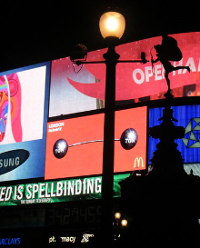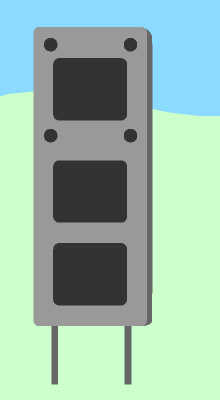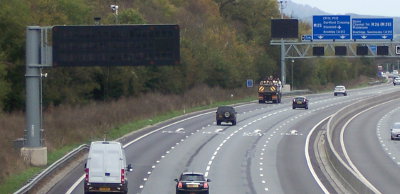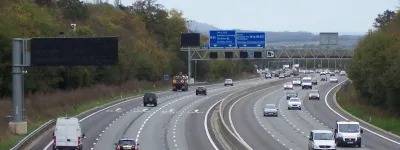
A matrix sign is an amazing thing: a panel of lights, arranged in a grid, in which each light can be switched on or off individually to create patterns that form symbols, letters or whole words. We take these things for granted now, of course: a matrix display of a much more modern kind makes up the screen that you're probably using to read this, and the colourful adverts that illuminate Piccadilly Circus, and a million other devices in the modern world. We're used to this technology now. But in 1969 it was a thing of wonder.
The key to this technology is the ability to control a very large number of lights in a simple way. You could wire them all up to individual switches, of course, but that would be wasteful and difficult to coordinate. Instead, they are cross-wired, along and down, with switches controlling each horizontal and vertical line. By switching a vertical and horizontal together, you illuminate the light where those lines intersect. With some simple electronics to interpret an electrical signal and operate the switches, a single pair of wires can carry remote control instructions for the whole matrix.
In the late 1960s, Britain was the world leader in the use of light matrix technology on road signs for two reasons. The first reason was that we had been experimenting with changeable signs of all types for a number of years and our research programme was well advanced, thanks to the urgent need for state-of-the-art signals for motorways. The second reason was that we were the only country in the world that was allowed to work on them.
The Geneva Convention governs the use of road signs internationally, and it establishes things like the use of red circles with diagonal bars on signs that tell you not to do something. One of its more obscure provisions was that, if one signatory country was experimenting with a new type of road sign, no other countries could try it out until the tests had been finished. It was meant for trialling new designs or symbols, but it meant that electronic matrix signs — which took years and years of development work — could only be used in Britain, simply because we had tried them first.
In the end, an amendment to the Geneva Convention had to be formed and ratified that provided an exception to the rule — but for a while, in the world of matrix signals, Britain was the only player.
Far too expensive
The M1 may have lost out to the M5 in the first round of motorway signal trials, but in 1966 the Ministry of Transport rolled out the first phase of its new motorway telephone networks, replacing the Post Office system that preceded it. The upgraded technology made it possible to install remote controlled signalling on the M1, and a new trial was installed on the motorway in Bedfordshire.

This work was now a major project for the Ministry, happening as part of the exciting Motorway Communications Development Programme. It was led by some of the Ministry's brightest lights: John Duff, the head of Traffic Engineering Division, and Ernest Walker. They recognised that Motorwarn's main failing was that it offered no explanation for the hazard lights and that, if drivers were going to take warnings seriously, the signals they created had to be capable of displaying more than three or four messages.
The first matrix signals they created were amazingly intricate: they had three panels arranged vertically, each with a complex matrix display. The top panel would show an advisory speed limit, with flashing amber lamps; the middle one was to display a pictogram indicating the hazard (such as a car on its side to indicate an accident ahead) and finally, on the third panel, a distance to the hazard, with the matrix capable of displaying something as complex as "1½m".
The experience gained from these tall monuments to electronic wizardry was valuable, but ultimately they weren't to last. They delivered an awful lot of information to the driver, and were capable of conveying complex and detailed information, but they were far too expensive. There would be nothing else of their kind for more than twenty years.
Not to worry, though: the cheaper solution, born out of this trial, was still incredibly sophisticated for its time, and by far the most complex and versatile changeable message sign to be produced anywhere in the world. The Ministry simply called it the Motorway Signal, or MS for short.
MS: where do you want to go today?

The M4 Severn Bridge was the first section of motorway to receive new signals, having many unusual hazards, including exceptionally high winds. In 1968 it was fitted with the earliest examples of the MS, specially built with double-width 26×11 pixel displays so that they could convey bigger and more complex messages. They had six flashing amber lamps and four red lamps. Ordinary Motorway Signals, with 13×11 pixel displays and the more familiar four amber lamps, were soon installed on the M4 near London and parts of the M1. They could show all sorts of messages, but most importantly of all, they could show the word "Fog". Finally the MPs had their fog warning signs.
What's quite astonishing about the MS, given how incredibly familiar and common it is even today, is that it was designed with a great deal of functionality that has never been exploited. They had the capability to show 70 different symbols, of which 50 were programmed at the outset and 20 were held in reserve for future use. Among the possibilities were "road narrows", "end of dual carriageway" and "two way traffic" symbols; the words "STOP" and (oddly) "GATE"; speed limits from 10 to 120 (allowing for future use of km/h); and distances in fractions of kilometres from "0,2" to "1,0".
The double-width Severn Bridge signals were intended either to show two symbols side-by-side, such as a lane closure and a speed restriction, or a word taking up both panels, like "SLOW". The inclusion of the word "HIGH" as well as "WIND" suggests that they may even have been capable of flashing two messages alternately.
At the end of any restriction, a circle with diagonal bar — reminiscent of the National Speed Limit sign — had the meaning "road clear".

It was also the intention that the new MS matrix signal would be installed on gantries above individual lanes, and even embedded in direction signs, where they would show arrows pointing in different directions to dynamically change the route that traffic was to follow to different destinations. This wasn't ever tried out, but those 50 symbols included arrows pointing in every conceivable direction to allow for it.
In parallel with the new signals, the new National Motorway Control System was set up in 1970, providing a coordinated way of controlling them. The NMCS had two control centres, one at Coleshill and one at Westhoughton, which normally each looked after one half of England but which were each capable of managing the entire motorway network if the other was incapacitated.
Before long every mile of motorway in England was equipped with MS equipment and the temporary Motorwarn system could finally be decommissioned, years after its sell-by date.
The MS is, remarkably, still with us and still routinely installed today. There are few major motorways where they are the only signals, but — on quieter routes, sliproads and, most often, as individual lane signals on overhead gantries — they are still going strong, more than forty years after they were first installed on the Severn Bridge. They received some upgrades in 1989, with the introduction of new matrix lights to form a red "X", reinforcing the instruction to stop given by flashing red lamps, and the replacement of the "road clear" symbol (which was wide open to litigation if the road proved not to be completely clear) with the new "End" indication.
In Scotland and Wales, however, trunk roads had been devolved for some time, and the new Motorway Signal was not adopted. Both now have matrix signals either very similar to, or identical to, those described here and used in England, but for a long time that wasn't the case. Remarkably, Scotland never rolled out the MS at all, and to this day in rural areas still uses a permanent installation of the Motorwarn signal.
Just like a normal road sign
The MS and NMCS reigned supreme for more than twenty years, some of the most advanced variable message signs in the world connected to a revolutionary national control system. In 1991, NMCS2 was set up, forming a new, more modern national control network, with the motorways around Manchester the first to benefit from the new technology. Initially thirty control centres nationwide looked after the system, but now there are just seven regional centres. It went hand in hand with the MS2, a new type of matrix display that could show longer written messages in two rows of twelve characters, and bringing us into the modern era of variable message signs. They are typically mounted on the left side of gantries with individual MS lane signals and supplement the individual lane symbols. The introduction of MS2 caused some naming confusion and the MS is, now, usually called the MS1.
The MS3 followed in 1999, normally mounted on its own cantilever on the motorway verge, with either a display of two rows of 16 characters or three rows of 18.
Remarkably, though, there was no more sophisticated way to show a pictorial symbol than the 1968-designed MS1 until 2008, when the Highways Agency announced that the MS4 was ready for use: a large-panel display capable of showing two colours, any number of high-definition pictograms, and mixed-case text in regulation Transport lettering just like a normal road sign.

The MS4 is the latest idea in motorway signalling and is capable of some impressive things, but what's truly remarkable is that the innovation that it represents is mainly in optics and illumination. The Highways Agency's Interim Advice Note 109/08 on its use states that "advances have been made in Light Emitting Diode technology that enables a wider viewing angle and a higher resolution display with two colours" — and that's all that has really improved since the earlier models.
What hasn't changed much in the preceding forty years is the type or concept of the signal itself, something that the Ministry of Transport refined to an incredible standard in a few short years in the 1960s.

Picture credits
- Photograph of Piccadilly Circus adapted from an original by Colin Pyle and used under this Creative Commons licence.

